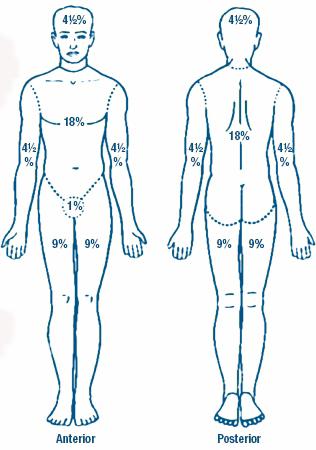Introduction
Burn injury is a global public health problem. In India over 100,0000 people are moderately or severely burnt every year. According to WHO report of 2014, burn injury accounted for over 300,000 deaths annually. The majority of these occur in low and middle income countries and nearly 50% occur in the South-East Asia Region.1,2 Globally, advances in burns treatmenthas decreased the mortality and prolonged the clinical course. Hence real time monitoring of mortality risk in burn patients is essential all through the clinical course for selecting and guiding the appropriate management protocol.3,4 Various mortality scales with varied prognostic factors such as sex, age, total burned body surface area (TBSA), percentage of full-thickness injuries, inhalation injury have been proposed.5
Burn is a wound in which there is coagulative necrosis of the tissue.1 Burn is one of the most common and devastating forms of trauma.6 It is an injury to the skin that damages or destroys skin cells and tissue7 Various metabolic and biological changes follow burn injury.8
Thermal burns are caused by intense external sources of heat, such as flames, scalding liquids, or steam. Burns resulting from an impaired driving crash are most likely thermal burns.
The severity of any burn injury is related to the size and depth of the burn, and to the part of the body that has been burned.7 Excess protein and enzyme loss can increase the possibility of infection, sepsis.7 Thermal injury results in significant pathophysiological changes by interplay of various mediators in early stages.9
This study was designed to estimate variations in biochemical parameters in the burn patients, since the levels of these substances are very important in letting the health care team to know how the body is responding to the different therapies that being provided and this will help the medical staff for proper management with less morbidity and mortality.
Types of burns
1. Thermal: direct contact with heat (flame, scald, contact) 2. Electrical : A.C. – alternating current (residential) D.C. – direct current (industrial/lightening) 3. Chemical 4. Frostbite
THERMAL INJURY is associated with anatomical, biochemical, physiological and immunological alteration which require special care.9
Extent of burn is estimated by RULE OF NINE1
Aims and Objectives of the study
The aim of the study is to evaluate the Liver Function Test and Serum Electrolytes in burn patients and its role in management of patient.
Materials and Methods
Source of data
The study was done on 50 burn inpatients and 50 healthy persons taken as controls from Mahabodhi Burns Critical Centre (MBCC), Victoria Hospital attached to Bangalore Medical College and Research Institute, Bangalore.
Method of sample collection
5 ml of venous blood obtained by venepuncture, centrifuged and the separated serum was used for estimation.
Sample was collected between 2nd day to 5th day after the burns.
Serum electrolytes ( sodium, potassium, chloride)
Liver Function Tests ( Total Protein, Albumin, Bilirubin, Liver enzymes) were analysed by BECKMAN COULTER Au 480 autoanalyser.
Statistical analysis
Parameters studied
Table 1
Discussion
Hyponatremia in burns
In burn patient intravascular volume is lost in both burned and unburned tissues. This process is due to an increase in vascular permeability, increased interstitial osmotic pressure in burn tissue and cellular oedema. Hyponatraemia (< 135 mEq/L) is due to extracellular sodium depletion following changes in cellular permeability. Hyponatraemia is frequent and so the restoration of sodium losses in the burn tissue is necessary.10 Measurement of serum sodium is not only a means of diagnosing dehydration, but it is a good guide for estimating and managing ongoing fluid loss.11
Clinical manifestation of hyponatremia9
Neurological: altered consciousness cerebral edema, seizures, coma.
Cardiac : decrease in cardiac output & BP, increase in HR
GIT: anorexia, nausea, vomiting
Deficit is based on the following formula:6
TBW X Wt in Kg (Desired sodium – Patient’s sodium)
TBW (Total Body Water) = 0.6 for males
0.5 for females
Hyperkalemia in burn
Hyperkalemia is mainly caused by cell lysis and tissue necrosis. Manifestations of hyperkalemia particularly affects cardiovascular system.9 Remove potassium from the body by means of calcium gluconate, potassium exchange resins or in serious cases haemodialvsis.
Liver function tests in burns
Alteration in liver function test is extremely common following major burns. The precise etiology of these changes is not known, but they usually are benign in character and resolve spontaneously. Patients who show severe and persistent derangements of the liver enzymes, including elevation of bilirubin, usually have some associated complication of their burns like wound sepsis so the prognosis is guarded5. Some studies have shown that serum AST, ALT & ALP raised between 50% - 200% from baseline.10
The skin injuries induce a strong inflammatory response and the release of vasoactive substances, which increases the skin permeability to water, albumin and even larger protein molecules. This process peaks during first 12-24hr, which is coupled with reduction in albumin mRNA response to burns. After this initial phase, hypoalbuminemia persists because of lack of its synthesis, its loss through damaged areas and deficiencies in nutritional support.6 Protein solution is not given in first 24hr because during this period proteins are no more effective than crystalloids in maintaining intravascular volume.11
Study done by Olivia et al showed that patients with albumin levels <2g/dl had a high mortality risk >80%.
Study done by J.H. Anadani, who divided patients into groups (group 1: 20-40yr, group 2: 40-60yr) showed slight raise in potassium level (14% in Gp 1, 24% in Gp2) and 4% decrease in sodium level in both groups.9
Conclusion
Liver plays a central role in burn injury and postburn outcome. Restoration of liver function especially albumin helps in better treatment of patients and decrease the mortality. Measurement of serum sodium is not only a means of diagnosing dehydration but it is good guide for estimating and managing ongoing fluid loss. Hyperkalemia should be managed in order to prevent cardiovascular effects. Burn represents devastating injury affecting nearly every organ system and leading to significant morbidity and mortality.










